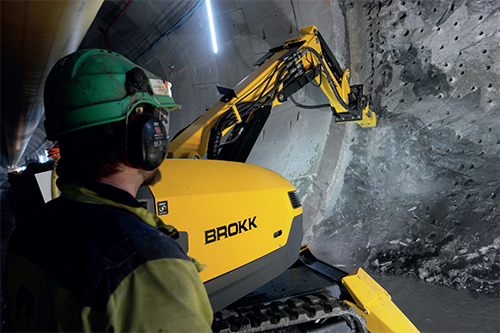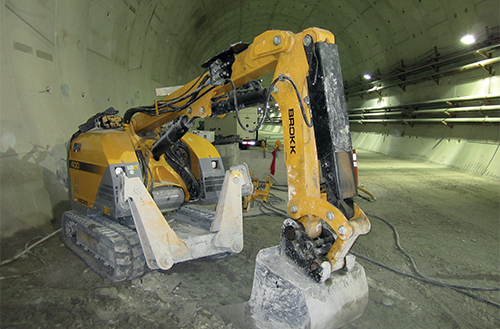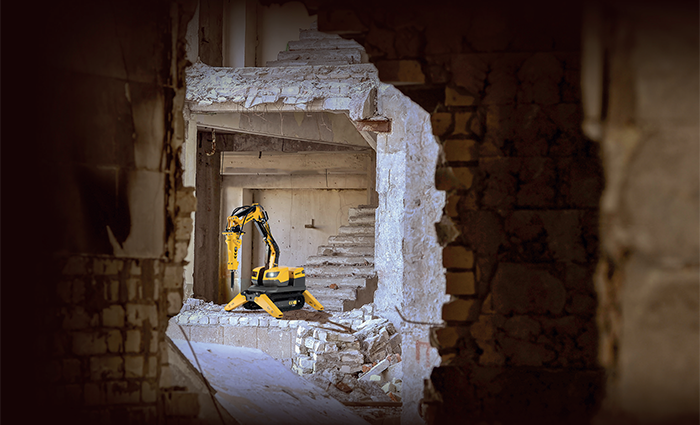An abundance of opportunity
There’s method in mechanization
Jeff Keeling takes a look at how jobsite mechanization offers cutting-edge construction and demolition industry solutions
The construction and demolition industries continue to see steady change. Contractors, laborers and project managers are pushing for safer and more productive solutions to transform modern jobsites while facing an ever-growing backlog of projects fueled by the $1.2 trillion Infrastructure Investment and Jobs Act. At the same time, ‘The Great Resignation’ and Baby Boomer mass retirements contribute to labor shortages across the board.
With all these factors at play, relying on manual labor is simply unsustainable – in terms of worker recruitment and retention, safety, productivity and overall cost-effectiveness. As a result, successful contractors think outside-the-box and supplement experienced crew members with technologically advanced equipment like robotic demolition machines to increase efficiency and reduce the physical strain on laborers. Additional mechanization options help contractors take advantage of current opportunities while accommodating industry trends.
Productivity boost
Handheld pneumatic breakers and other highly physical methods have been commonplace on jobsites for decades. However, increased jobsite mechanization has allowed contractors to revolutionize productivity.
 A demolition robot paired with a hydraulic breaker, for example, improves upon previous productivity goals with an impressive hitting power, on par with excavators three times their size, and offer industry-leading power to weight ratios. These compact machines access some of the most confined and restrictive jobsites – including those with dust, vibration and noise restrictions as well as low floor loads. At 31 inches (79 centimeters) wide and weighing 1,235 pounds (560 kilograms), the most compact units are small enough to fit through standard doorways and light enough to be transported on passenger elevators, making them ideal for confined spaces and interior demolition projects. Larger models are available with higher power ratios for more challenging applications.
A demolition robot paired with a hydraulic breaker, for example, improves upon previous productivity goals with an impressive hitting power, on par with excavators three times their size, and offer industry-leading power to weight ratios. These compact machines access some of the most confined and restrictive jobsites – including those with dust, vibration and noise restrictions as well as low floor loads. At 31 inches (79 centimeters) wide and weighing 1,235 pounds (560 kilograms), the most compact units are small enough to fit through standard doorways and light enough to be transported on passenger elevators, making them ideal for confined spaces and interior demolition projects. Larger models are available with higher power ratios for more challenging applications.
By employing these heavy-hitting machines, contractors can greatly increase efficiency in applications previously limited to large crews with handheld equipment. For example, one contractor was able to cut their demolition crew by a third during nearly one-million-square-foot (92,903-square-meter), multi-level tear out. The two 2,183-pound (990-kilogram) demolition robots were able to access floors where even skid steers were deemed too heavy. With each robot only requiring a single operator, the contractor was able to better utilize remaining employees across simultaneous jobsites while increasing productivity and lowering overall labor costs.
Safety benefits
For many in construction and demolition, increased safety is one of the biggest benefits of mechanization. Remote-controlled demolition equipment addresses some of the most pressing safety concerns these industries face.
With an operating distance of up to 984 feet (300 meters), remote-controlled units physically distance employees from harmful silica dust, as well as the strong vibrations of handheld equipment such as breakers, rivet busters and chipping guns. Long-term use of these common demolition tools is linked to a number of chronic injuries, including carpel tunnel syndrome, nerve damage and hand-arm vibration syndrome.
Additionally, remote-controlled demolition machines help prevent one of the most common causes of serious work-related injury and death in construction – falls. A remote-controlled unit allows operators to remain a safe distance from ledges and other fall hazards. This provides peace of mind for workers and project managers, but also increases productivity by minimizing the need for erecting fall protections.
For contractors using remote-controlled machines, these safety benefits can quickly add up to significant savings on workman’s comp and insurance premiums. Remote operation paired with smaller crew size can significantly lower worker liability costs by limiting personnel in confined spaces or hazardous operations. One concrete cutting contractor who made the switch to demolition robots has seen a decrease in annual workers compensation claims by about 50 percent. The company has also seen a 25 percent decrease, or about $40,000 – $50,000 savings, in injury costs per year. Another concrete cutting operation reduced its experience modification rate (EMR) by adding demolition robots to their equipment fleet. Insurance companies calculate EMR based on a company’s safety record. Higher EMRs result in higher insurance premiums.
Recruitment and retention
Implementing cutting-edge technology also offers some powerful recruitment and retention tools. When it comes to safety, for example, the workforce is well-aware that quality of life and length of career can be significantly affected by injuries and silica dust exposure. At this time, the median age of a construction worker is 42.3 years. Contractors who invest in mechanization reduce the amount of dangerous and hard manual labor workers must perform, which is a powerful benefit to young and experienced workers alike. A young employee may consequently see construction as a long-term profession while an experienced worker may see it as more realistic to remain in the industry for the duration of their career.
Cutting edge technology also attracts younger workers. For one concrete cutting company, including advanced robotic technology in their fleet helped reduce the median age of their 300- strong workforce to just 25 years old and cut turnover ten per cent. The machines also allowed the contractor to do more work with fewer people, increasing productivity 17 percent over three years.
The mechanization advantage
It’s both an exciting and challenging time for construction and demolition. Opportunities abound for contractors, especially those who find creative ways to recruit, retain and best use the skills of their workers. Technological advances, such as robotic demolition, can help change the way contractors work and make it possible to thrive in today’s environment while preparing for the future. Mechanization allows companies to quickly adapt to changes in labor, process or regulation, keeping them ahead of the curve – and the competition.
Jeff Keeling
www.brokk.com
Jeff Keeling is the vice president of sales & marketing for Brokk Inc. Brokk has been the world’s leading manufacturer of remote-controlled demolition machines and attachments for over 45 years. Through continuous innovation in engineering and design, Brokk is able to offer unique solutions to multiple industries worldwide, including construction, demolition, mining and tunneling, cement and metal processing, nuclear and other specialty applications. .
